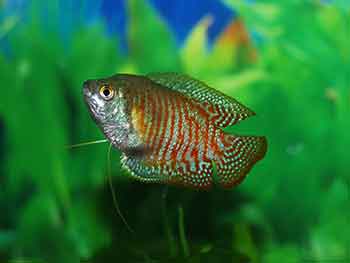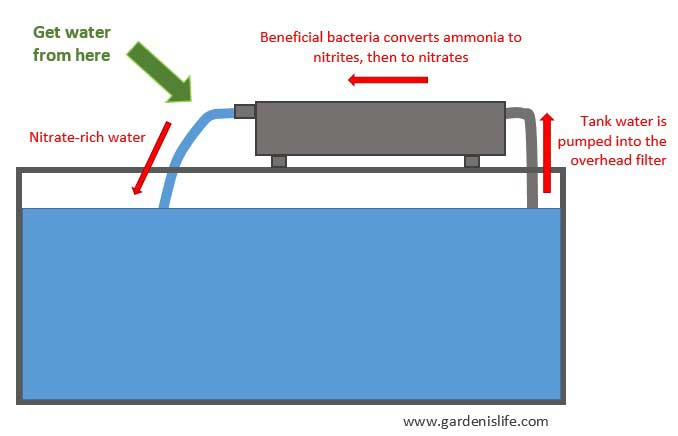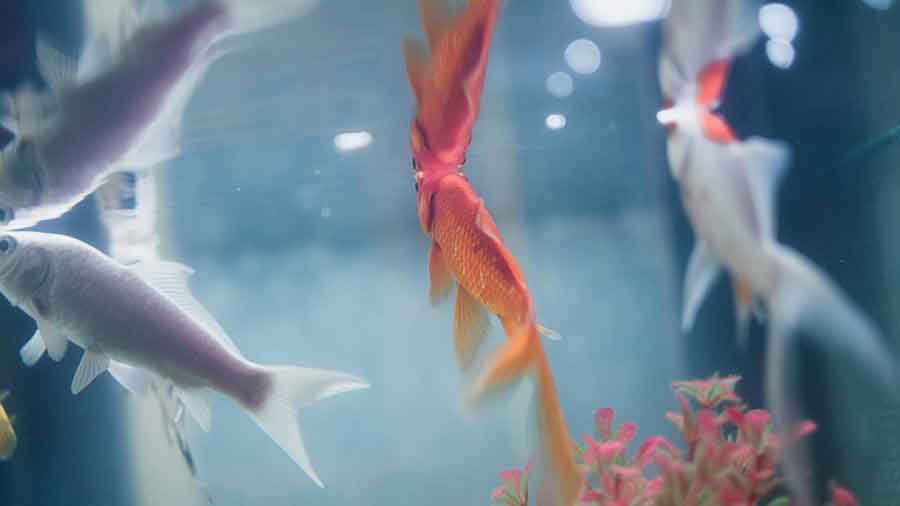I like keeping fish in aquariums. I have 2 50-gallon tanks at home and several of those small 15-gallon fish tanks. Mostly, I have Lake Tanganyika and Malawi cichlids since they are relatively easy to take care of. I also have a number of South American cichlids, mostly dwarfs.
My favorite is the ram cichlid, those blue specks are just a sight to behold.
Part of taking care of my fish at home is to change the tank’s water every month. In order not to waste the fish tank water, I tried watering it to my potted plants. I have done this so many times already and the result is wonderful. So, to answer the question, “is fish tank water good for the plants?” the answer is yes. Based on research, the reason is that the water in the aquarium is rich in nitrogen.
Nitrogen is a Fertilizer for Plants
Plants need 3 important nutrients. These are nitrogen, phosphorus, and potassium. Phosphorus is needed for root development while potassium is needed in the flowering or fruiting stage of the plant.
One important nutrient that a plant must have is nitrogen. Nitrogen is needed in the plant’s vegetative stage. This is the stage where plants vigorously grow leaves and shoots.
Nitrogen is needed by plants to produce chlorophyll, which makes the leaves green.
Chlorophyll, which is a green pigment, is present in all green plants and is responsible for the absorption of light to provide energy for photosynthesis. Without photosynthesis, they can’t make their own food so they eventually die.
Beneficial Bacteria in Fish Tanks Produces Nitrogen
Some people may think that the fish survive in aquariums if they have enough water and food. But what really happens is that the water in the aquarium is slowly killing all the fish inside.
The reason why they survive is because of the presence of beneficial bacteria.
These types of bacteria should be established enough in order to keep the fish happy. In fish tanks, they can be found in the fish tank’s filtration system. This is why it is very important to have a filtration system in the tank. Some people tend to think that the filter’s purpose is just to keep the water clean. But there really is something more to it.
There are biological processes happening inside the tank’s filtration system. These bacteria are the same bacteria that produce a type of nitrogen that plants really like.
The Nitrogen Cycle is Naturally Occurring in Aquariums
When a fish tank is newly set up, nitrogen is not yet present. At his stage, the water is actually harmful to the fish. This is why seasoned fish hobbyists and breeders will always advise you to cycle the water first before adding the fish.
It is best to introduce the fish 3-4 weeks after you first poured water into your fish tank. “What is cycling?” you might ask. When they say cycle the water first, they are referring to the nitrogen cycle. The nitrogen cycle is this:
- Fish excrete ammonia
- Bacteria turns ammonia into nitrites
- Bacteria turn nitrites into nitrates.
- Fish “breathes in” the nitrates, and the cycle begins again
Fish Excretes Ammonia
Fish and other organic materials such as fish poop and uneaten fish food excrete ammonia. As the uneaten fish food decomposes, it gives off ammonia. In a lake, river, or sea, it’s all good because the vast volume of water dilutes this ammonia.
When you’re keeping fish at home it needs to be managed as it is very toxic to the fish.
When setting up a new aquarium, if you really must add fish, then add those hardy types. There are actually some types of fish that can take oxygen from the air aside from water.

One of these types is the labyrinth. Some fishes belonging to this family are the gourami, climbing perch, and Siamese fighting fish.
What we should be aiming for is to wait until the toxic ammonia turns into harmless nitrates, which is good for the plants
Beneficial Bacteria Turns Ammonia into Nitrates
The beneficial bacteria are introduced into the fish tank when you put a substrate or a filter material. The bacterium is called Nitrosomonas sp. This good little bacterium eats ammonia and converts it to nitrite. Now, nitrite is much less poisonous to the fish than ammonia, but it’s by no means a good thing.
It stops the fish from taking up oxygen. Enter the Nitrobacter sp. This good bacterium eats nitrite and converts it to nitrate.
Luckily nitrate happens to be the favorite food of plants.
Also, the fish will tolerate a much higher level of nitrate than they will ammonia or nitrite. This is pretty much the nitrogen cycle. When the aquarium system has sufficient numbers of these bacteria to completely process the ammonia and nitrites it is said to have “cycled”.
It Takes 4 Weeks to Produce the Nitrates
Don’t water your plants yet with fish tank water that has been around for a week or two. It doesn’t contain the nitrates yet which the plants like. Remember, it is the nitrates present in the water that is the fertilizer for the plants.
As a general, rule a brand new system will require about 4 weeks to cycle at around 20˚C. It will take longer in colder water. If you want to be sure, there are nitrates kits available commercially for fish tanks.

Get the Most Nitrates From Your Fish Tank
Technically, you can just scoop out water from the fish tank and use it to water your plants. I do this when I change the water in the fish tank. I get about ¼ of the aquarium water and replace it with conditioned, tap water.
However, when you think about it, fish continually excretes ammonia. Before ammonia turns into nitrates, it becomes nitrites first. So when you scoop out water from the fish tank, in all probability, it still has ammonia and nitrites, along with the nitrates.
So where do we get the greatest amount of nitrates? The answer is the water directly coming out of the filtration system.
Overhead Filtration System Gives the Most Nitrates
Most new beginner type aquarium systems use a filtration system that is submerged in the water. Examples are the undergravel filter and sponge filter. They’re good systems, especially if it’s just a fish or two.
But since they are underwater, ammonia, nitrites, and nitrates are perpetually mixed in a soup.
You just want to get the nitrates. What you need is a system that can extract the water from the main fish tank, pass it through a series of filtration substrate to remove the toxic ammonia and nitrites, and release non-toxic, fish-friendly, nitrate-rich water back into the main tank.
This is how an overhead filtration system works. The important thing here is that the fish tank water is isolated from the main tank while it is being filtered.
You get the water that is being released by the system before it goes back into the fish tank.

A Few Facts About Beneficial Fish Tank Bacteria
- They must colonize a surface (gravel, sand, synthetic biomedia, etc.) for optimum growth.
- They need oxygen in the water to live and work. Therefore, there must be sufficient water movement for them to survive.
- Nitrifying bacteria have long reproduction times.
- Under optimal conditions, Nitrosomonas sp.may double every
- 7 hours and Nitrobacter sp.every 13 hours. More realistically, they will double every 15 - 20 hours. To put that into perspective. In the time that it takes a single Nitrosomonas sp. cell to double in population, a single E. Coli bacterium would have produced a population exceeding 35 trillion cells.
- As a general rule, a brand new system will require about 4 weeks to cycle at around 20˚C. It will take longer in colder water.
Biological Filter Media for a Bacteria Colony
To get the maximum amount of nitrates in the water, you must have a good size of bacteria colony living in your biological filter media. The secret to having optimal nitrate-rich water is to have a filter media that can offer the most amount of surface area for the bacteria to thrive on. Here are some of the filter media you can use.
- Gravel
Gravel is cheap but heavy to use. It is also limited in terms of surface area.
- Bio Rings
Bio rings have greater capacity comparing to most other filter media. It can hold at once a lot of water. This makes the filtering process more efficient. The complex pore system of this filter allows beneficial bacteria to survive more efficiently.
- Bio balls
Bio-balls provide a large surface area. This intensifies the efficiency of filtration. Though this media supports organic bacteria to thrive, what these basically are is plastic balls. But the plastic doesn’t harm the water in any way.
- Ceramic rings or “noodles”
The ring provides sufficient space to nurture desirable bacteria colonies. The perforated ring structure enables sufficient water flow.
Reference:
Backyard Aquaponics Magazine. Issue 1. 2007










